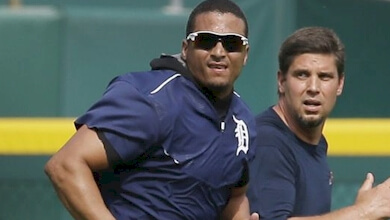
Victor Martinez runs with current Detroit strength and conditioning coach Chris McDonald during a rehab stint earlier this season.
If the name “Bo” is brought up in Michigan, people instantly think of Bo Schembechler and University of Michigan football.
The legendary former Michigan head man is known for all the right reasons for his two decade-long stint with the Wolverines.
The same can’t be said about his time with the Detroit Tigers.
Although not fondly remembered for his stint as president of the Tigers from 1990-1992, it can be said that he ushered in a new era of strength and conditioning for the organization by hiring Russ Miller in 1991, who served as the trainer for the Michigan Wolverines football team from 1979-90.
By taking on the position, which Miller had previously never held for a professional sports team, he became the first certified physical therapist to serve as the head trainer of an MLB franchise.
According to Miller, when the franchise was sold in 1992 by Domino’s Pizza founder Tom Monaghan to Little Caesars co-founder Mike Ilitch, he was allowed to keep his spot on the Tigers’ training staff largely as a result of the backing of club executive Gary Vitto, who served as assistant general manager during Ilitch’s first season as owner of the franchise.
After surviving the ownership change, Miller continued to serve as head trainer and also as medical director of the club until announcing his retirement in 2002.
In a recent interview, Miller, 72, he talks about whether or not he was nervous when he made the move from college football to the big leagues, the difference in training pro athletes plus much more.
DAC: When Bo Schembechler took over as president of the Detroit Tigers in 1990, he made a commitment to adding conditioning coaches to the organization’s minor league clubs, and then he brought you on in 1991 to serve as the trainer for the ballclub. Upon taking the position, were you nervous about what would be expected of you in making your foray into professional sports?
Miller: I had a little bit of concern. I was going from a safe position at the University of Michigan, which was a rock-solid program, to heading the whole entire training program for the first time in Tigers history. I only had known college athletes from 1961 until 1990, and then was tasked with taking on 40 players from the major league roster and hundreds of minor leaguers. Sparky (Anderson) appreciated my knowledge and experience, though.
DAC: Would you have made that jump from college athletics to Major League Baseball for anyone else?
Miller: No. I had known Jerry Glanville for many years, and he was the head coach for the Houston Oilers in the 1980s. He asked me to take on the trainer position, and I turned him down.
DAC: How different was it training pro athletes, such as Alan Trammell, Lou Whitaker and Kirk Gibson?
Miller: The Tigers were the greatest group of guys to work with. Dave Bergman and Alan Trammell were awesome to work with. I only had one or two mild situations with pro players, which came when I gave recommendations that were not listened to. When traveling (with the Tigers), I would have to give recommendations while being on the phone with the GM. I would have to make a snap decision on whether or not to put players on the DL (disabled list). It’s why I would say to the GM, ‘If I screw up, you better back me up a little bit.’
DAC: Only half of the minor league trainers were certified when you joined the club. What’s the best way to get acclimated to the work of an athletic trainer?
Miller: To do everything as a trainer for the minor league teams. I was responsible for setting up the whole (conditioning) program for Detroit, and would spend my off days with the minor league trainers.
DAC: What did you try to implement when you joined the Tigers, and what was the biggest transition you had to make?
Miller: I wanted to bring people into spring training to get them ready to work on baseball skills. The biggest transition for me was with the minor leagues because when I took over, there wasn’t a trainer for the minor league teams. I also initiated an in-season conditioning program for each of the minor league teams.
DAC: Arm injuries have become quite the predicament for young pitchers. Why do you think the game of baseball has been struck with this widespread issue, and what can be done to prevent such injuries going forward?
Miller: We are taking young people and having them throw plus play too much baseball. I’m also not a fan of these travel baseball teams, and parents need to cut down on the overuse of (these) young guys. When you throw a fastball, the torque you put on your arm is (at) max (level), and young guys can’t take it. Parents are the worst, and we are too much of a one-sport (society.)


